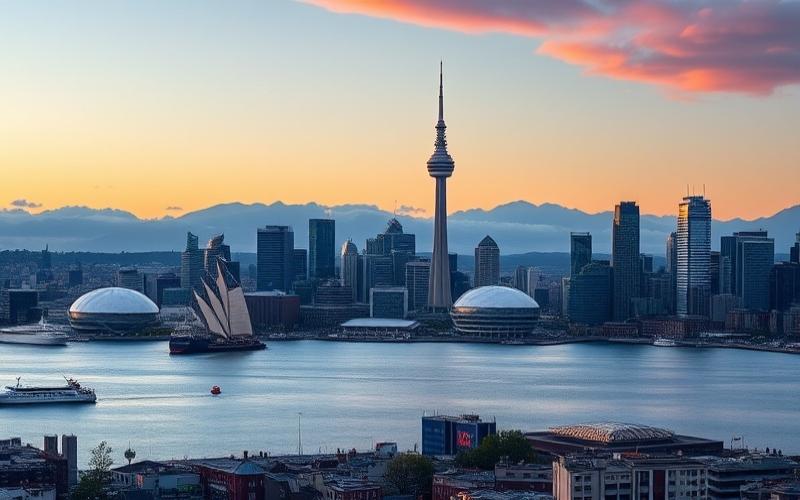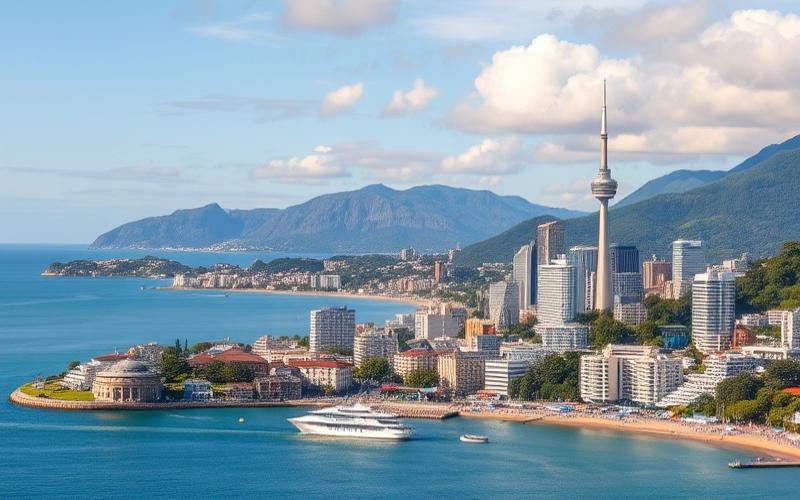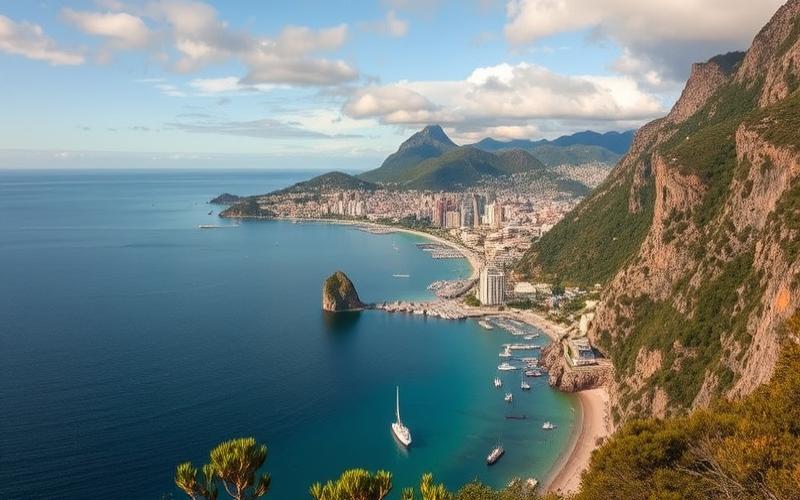
 Published on and written by Cyril Jarnias
Published on and written by Cyril Jarnias
As New Zealand continues to attract residents and investors with its idyllic setting and thriving economy, certain cities in this island nation are emerging as premier destinations where real estate prices are projected to skyrocket by 2030.
These cities, once overlooked, are seeing their popularity grow due to various socioeconomic factors, such as improved infrastructure, increased job opportunities, and a growing appeal for the region’s stunning natural landscapes.
Exploring Promising Cities
This article aims to explore these promising cities, their specific attractions, and the reasons why they are on the verge of becoming real estate hotspots.
By revealing the names of these booming localities, you’ll discover why investing now could prove to be an immensely lucrative decision.
Forecasts on New Zealand’s Real Estate Price Explosion
The national median house price in New Zealand reached NZD 807,164 in February 2025, signaling a gradual recovery of the real estate market after a period of slowdown. Economic forecasts indicate a moderate increase in national property values of about 5% for the year 2025, with an expected sales volume growth of 10 to 15%. Over the period leading up to 2030, the market is projected to grow at an average annual rate of nearly 4.3%, reaching approximately USD 1.10 trillion.
Key Economic and Demographic Factors Influencing Price Increases:
- Gradual decline in mortgage rates, stimulating credit access and encouraging purchases.
- Continued growth of the urban population in major cities (Auckland, Wellington, Christchurch), fueled by immigration and local demand.
- Persistent structural gap between supply and demand: despite several major residential projects underway or announced until 2030 (notably in build-to-rent), the pace remains insufficient to meet demographic growth.
- Imminent introduction of a debt-to-income ratio (DTI) cap, which may temporarily slow some buyers but aims to prevent market overheating.
- Government policies focused on affordability for first-time buyers but still considered limited in the face of market dynamics.
| Factor | Anticipated Impact |
|---|---|
| Mortgage Rates | Supports demand through more attractive conditions |
| Urban Growth | Upward pressure on prices |
| DTI Caps | Temporary moderation of borrowing capacity |
| New Supply | Insufficient to meet demand |
Cities Where a Relative Price Explosion is Anticipated:
Major metropolises such as Auckland remain at the heart of this upward trend due to their sustained economic growth and international appeal. Wellington also attracts local and foreign investors through its political status and innovative sectors. Christchurch benefits from a strong post-seismic recovery with several key urban projects expected before 2030.
List of Cities Under Pressure:
- Auckland
- Wellington
- Christchurch
Current Trends in the New Zealand Real Estate Market:
- Growing interest from international investors seeking political/financial stability.
- Increased development in the build-to-rent segment and specialized student housing; rapid rise in the senior residential sector (“living capital”) to address demographic aging.
Major Urban Projects by 2030:
- Massive construction around university hubs;
- Increased modernization/renovation in central neighborhoods;
- Creation or expansion of data centers enhancing regional economic attractiveness.
Social and Economic Perspectives:
The anticipated acceleration – even if moderate – reinforces the divide between established homeowners fully benefiting from this asset appreciation and new entrants facing persistent financial accessibility challenges. Rental tension could intensify in certain neighborhoods while public policies will need to balance stimulating the economy through foreign/private real estate investment and providing concrete support to low-income households or first-time buyers.
In summary, although less explosive than in the early 2020s, New Zealand’s upward trend will largely rely on a few major urban centers driven by vigorous demographics, targeted sector innovations (student/senior/build-to-rent housing), and an overall favorable financial environment until the 2030 horizon.
Good to Know:
Recent analyses show that real estate prices in New Zealand could experience a significant surge by 2030, particularly in cities like Auckland, Wellington, and Christchurch. This rise is mainly attributed to rapid urban population growth, with a notable increase in households seeking to settle in urban areas. Mortgage interest rates remaining relatively low, along with government policy encouraged by sustainable development and infrastructure initiatives, also contribute to this trend. Large-scale urban development projects coupled with strong interest from international investors reinforce current upward market trends. However, this price increase could exacerbate social inequalities, making homeownership even more difficult for low-income New Zealanders, thereby impacting the local economic and social fabric.
Emerging Cities with High Growth Potential
| City/Neighborhood | Notable Projects | Demographic Dynamics |
|---|---|---|
| Auckland Outskirts | Rail lines & busways | Strong growth |
| Hamilton | Residential development, modern schools | Young population |
| Tauranga | Port redevelopment | Rapid growth |
| Christchurch East | New residential areas | Post-seismic attractiveness |
Emerging Cities with High Growth Potential
- Auckland (especially its outskirts): National economic engine with rapid urbanization and massive transport infrastructure projects to support expected demographic growth.
- Hamilton: University city and tech hub, benefits from a growing youth population, a dynamic real estate market, and investments in educational and residential facilities.
- Tauranga: Thriving port hub due to the modernization of its logistics facilities, attracts new residents through quality of life and local job dynamism.
- Christchurch East: Accelerated reconstruction since past earthquakes; rapid development of new residential neighborhoods appealing to families and investors.
Factors Favoring Growth
- Major public projects (rail extensions, rapid busways)
- Local policies focused on housing accessibility
- Private investments in new real estate sector
- Modernization of educational and hospital infrastructure
- Establishment of innovative companies in technology, health, or sustainability sectors
Observed Demographic Trends
- Marked influx of population to these medium-sized or peripheral cities seeking a better cost/quality of life balance
- Continued urbanization with regular creation of new residential neighborhoods
- Economic diversification through the emergence of activities related to technology, specialized services, or port logistics
Major Investments in Local Infrastructure
Non-exhaustive list:
- New rail lines around Auckland to streamline urban mobility
- Extension of the school network (Hamilton)
- Expanded hospitals (Christchurch)
- Rehabilitation of the commercial port (Tauranga)
Implications on the Local Real Estate Market — Forecasts Until 2030
Over half of New Zealand’s neighborhoods saw their real estate values stabilize or increase in early 2025. Overall price increase forecast: +3.8% in 2025 after a calmer period between 2021–2024. Experts anticipate a moderate but steady continuation of increases until 2030 in these attractive regional hubs.
Opinions and Expectations from Economic/Urban Planning Experts
“Medium-sized cities are now fully benefiting from widespread remote work: their relative accessibility combined with a preserved natural setting attracts young professionals and families alike. The acceleration of public construction confirms a snowball effect on local attractiveness.”
“Economic diversification around digital or health sectors firmly anchors some non-Auckland cities in the New Zealand landscape.”
Comparison with Other Major Cities
| Criterion | Auckland | Wellington | Christchurch | Hamilton | Tauranga |
|---|---|---|---|---|---|
| Job Growth | Very Strong | Strong | Medium | High | High |
| Investor Appeal | Maximum | Maximum | Medium | High | High |
| Real Estate Prices | Very High | Medium–High | Medium | Dynamic | Dynamic |
Auckland remains essential but faces gradual saturation; Wellington capitalizes on its administrative status while Christchurch regains its post-seismic dynamism. Areas like Hamilton or Tauranga now show superior potential thanks to rapid catch-up in economic and qualitative terms.
Good to Know:
In New Zealand, cities like Hamilton, Tauranga, and Queenstown are experiencing rapid development, supported by notable economic expansion. Hamilton benefits from its proximity to Auckland and significant investments in transport and housing, accelerating its urbanization. Tauranga, on the other hand, enjoys a boom in the technology sector and economic diversification, attracting new populations. Queenstown, a popular tourist destination, attracts major investments in hotel and residential infrastructure. These cities are recording accelerated demographic growth and equipping themselves with modern public facilities. This expansion is expected to lead to a significant increase in real estate prices by 2030, sparking investor interest. Experts anticipate that these regions will surpass other New Zealand cities in terms of dynamism and attractiveness, due to growing public and private investments, strengthening their strategic positioning in the national real estate market.
Real Estate Investment: Areas to Watch by 2030
Current economic trends in New Zealand indicate a solid recovery phase after the 2023-2024 recession, with GDP growth expected at 2.9% for 2025-2026. This dynamic is supported by government policies favoring investment, such as the “Investment Boost” scheme, which grants an immediate 20% tax deduction on eligible new assets, including commercial and industrial buildings. Lower policy rates and a return to a trade surplus also contribute to strengthening investor confidence.
Urban Areas with High Appreciation Potential
- Auckland: The country’s economic capital, Auckland remains New Zealand’s demographic and economic engine. The rapid expansion of transport infrastructure (light rail under development, highway projects), managed urban densification, and attractiveness to technology sectors reinforce its status as a major hub.
- Wellington: Administrative and technological center, Wellington benefits from a continuous influx of skilled professionals. Public investments in sustainable transport (modern tramways) and the tertiary sector stimulate real estate demand.
- Christchurch: City in dynamic reconstruction since the 2011 earthquake, Christchurch attracts with its still competitive prices and vast urban projects (smart residential neighborhoods). Its strategic positioning as a logistics hub enhances its appeal.
| City | Population Growth | Infrastructure Projects | Main Assets |
|---|---|---|---|
| Auckland | +1.8%/year | Light rail, residential zones | Economic capital & job diversity |
| Wellington | +1%/year | Electric tramways | Administration & tech |
| Christchurch | +0.9%/year | Connected eco-districts | Affordable prices & urban innovation |
Factors Influencing Real Estate Growth
- Pro-investment government policies
- Massive development of urban infrastructure
- Demographic pressure due to skilled immigration
- Sustainable initiatives aiming for carbon neutrality in housing
“New Zealand attracts with a unique combination of economic assets – political stability, tax incentive measures, and long-term vision for sustainable urban planning – which place especially Auckland but also Wellington or Christchurch at the center of wealth strategies until 2030.”
According to Cyril Jarnias (real estate expert)
Compared to less urbanized or rural regions (inland Northland or West Coast), these metropolises offer:
- More stable rental yields,
- Increased market liquidity,
- More opportunities linked to new technologies,
- And better resistance to economic shocks thanks to local dynamism.
Summary for Investors
Major urban areas — led by Auckland — thus present superior potential due to the combined effects of massive public support for productive investment and urban renewal oriented towards green growth. These factors should continue to fuel land appreciation until the 2030 horizon much more than in peripheral regions where demographic slowdown generally limits prospects for rapid real estate asset valorization.
To watch particularly:
Auckland ➔ overall dynamism
Wellington ➔ administrative stability & innovation
Christchurch ➔ strong resilience capacity & attractive prices
Good to Know:
In New Zealand, the cities of Auckland, Wellington, and Christchurch are to watch by 2030 due to their strong urban growth and property appreciation potential. Demand is fueled by government policies promoting sustainable development, significant population increases, and major transport infrastructure projects, such as the City Rail Link in Auckland. According to the local real estate agency Bayleys, these areas are comparatively more attractive than other regions of the country due to their promising economic dynamics. Economic forecasts indicate a steady rise in real estate prices, especially in neighborhoods well-served by transport and close to business centers. In contrast, some rural areas may not benefit from the same momentum, making Auckland, Wellington, and Christchurch essential hubs for real estate investors.
Disclaimer: The information provided on this website is for informational purposes only and does not constitute financial, legal, or professional advice. We encourage you to consult qualified experts before making any investment, real estate, or expatriation decisions. Although we strive to maintain up-to-date and accurate information, we do not guarantee the completeness, accuracy, or timeliness of the proposed content. As investment and expatriation involve risks, we disclaim any liability for potential losses or damages arising from the use of this site. Your use of this site confirms your acceptance of these terms and your understanding of the associated risks.














































